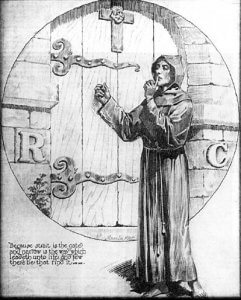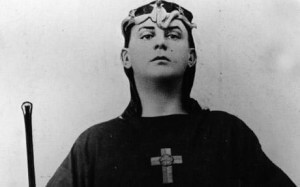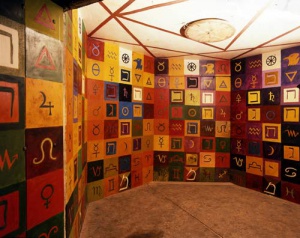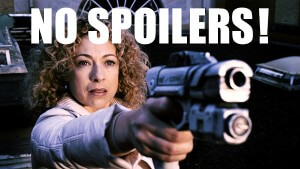 There are a few interesting posts around at the moment about the importance of the Christian religion within the Golden Dawn and much collective agreement that this particular religion was vital, particularly of the Second Order. The evidence appears fairly conclusive with the 5=6 being a Rosicrucian ritual and this equals being a Christian. There is also the important matter that historically Christian life was vital to many within the Golden Dawn structure.
There are a few interesting posts around at the moment about the importance of the Christian religion within the Golden Dawn and much collective agreement that this particular religion was vital, particularly of the Second Order. The evidence appears fairly conclusive with the 5=6 being a Rosicrucian ritual and this equals being a Christian. There is also the important matter that historically Christian life was vital to many within the Golden Dawn structure.
However, the devil (in this case literally) is in the detail and the conclusive evidence fails before one of the central planks of the Golden Dawn philosophy – that of syncretism. The idea of the Golden Dawn was to take different ideas and aspects of magic which on the surface appear dissimilar and weave them into a new coherent whole. This is why you see lots of different types of magic within the Golden Dawn system. Sometimes they are jacked under the bonnet more or less completely, such as cabbalism and other times they are a bit like a set of Ikea shelves where the person has given up on the instructions and wacked in the screws with a hammer.
A syncretic approach denies the perfection of a complete system as other systems might perform that approach much better. Ironically this idea applies to the Golden Dawn itself. There is a move within the modern Golden Dawn to ignore syncretism and define something as a pure Golden Dawn system and stick to it religiously. The implication was that the Golden Dawn was once a pure system in its own right and not the mongrel which emerged, howling at the moon, from the 19th century magical systems. In this mode of thinking, Christianity within the Golden Dawn follows a simple line of programming code. If the members of the Golden Dawn were Christian and Rosicruciasm was Christian, then you have to be a Christian to enter the Second Order.
There is a slight problem here. If Golden Dawn members were Christian, to do and perform these rituals and follow these teachings they could not have been orthodox in their beliefs. In fact, some modern Golden Dawners claim that the Christianity they followed was “gnostic.” However, there is nothing in the individual beliefs of Golden Dawn people which suggests any such “heretical” thought. In the case of Whare Ra the form of Christianity was more mystical Anglicanism and taken very seriously. Some of the articles written by Whare Ra members would not look out of place in any Church magazine. The point was that they were being asked to accept something else to work alongside that religion to help them understand it. In many ways ritual magic was a more efficient form of prayer. They had adopted a syncretic philosophy and placed magic within their Christian framework.
Where is Christ in the outer order?
When most people think “Golden Dawn” they think it refers to the entire system (this is not helped by people like me calling what we do Golden Dawn magic). But the Golden Dawn is literally the outer order which makes up the five grades of the 0=0 to 4=7. These were the only initiations that Mathers and Westcott ever received as a system. If you look at these rituals the Christian influence is very low key and where it exists it is framed within a Cabbalistic worldview. Magically we have Ancient Egyptian godforms, and an inner structure based around Jewish Cabbalah. There might be a couple of Christian references, but these are mostly literary.

This guy is clearly Christian
Those claiming the GD was “Christian” downplay the role Egyptian Godforms saying that these were not the same as using Egyptian Gods. Technically they are correct. Godforms are astral masks of gods which the magician wears and are not a pure form of spirit possession (which would be required if you were dumb enough to try using gods directly). As the rituals say, “the priest who wears the mask of [insert god] speaks and says…” These GD ‘masks’ are built from specific magical symbols which are designed to create a particular energy and a response from the candidate. The Golden Dawn went out of its way to avoid spirit possession by not even allowing its officers to take on the godforms themselves, but instead have them projected upon them by the Hierophant.
But the Egyptian choice of gods, along with the references to the Book of the Dead cannot be ignored. If the Golden Dawn were a Christian order it would have chosen Christian gods or angels who should have been able to do this better. Instead we see the GD using Gods magically without any hint of religious involvement.
The 0=0 explains the Golden Dawn’s attitude to religion generally. In the 0=0 you are told that the oath contains “nothing contrary to your civil, moral or religious duties” in other words you do not have to follow a specific religious line to be a member. The same Neophyte ceremony, it is pointed out that you must all religions in reverence because they all contain a fragment of truth. This is a statement of syncretism if ever there was one.
What we can see from this is that Christian symbolism is played down in the outer order and takes a backseat to imagery which would be considered pagan and placed within a cabbalistic context.
Jesus within the 5=6
 In the 5=6 it would appear that Christianity suddenly becomes king. Paganism is left at the door of the vault in favour of an advanced and totally Christian Rosicrucianism. You can’t really go anywhere without (in my case) literally tripping over Christian symbolism. There is a picture of dying Christ on the pastos alongside another standing before the seven lamps of revelation. There are clear statements which imply that the vault of CRC is that of the tomb of Jesus.
In the 5=6 it would appear that Christianity suddenly becomes king. Paganism is left at the door of the vault in favour of an advanced and totally Christian Rosicrucianism. You can’t really go anywhere without (in my case) literally tripping over Christian symbolism. There is a picture of dying Christ on the pastos alongside another standing before the seven lamps of revelation. There are clear statements which imply that the vault of CRC is that of the tomb of Jesus.
But thinking that is ignoring what has gone before within the GD. The candidate has through his two and half symbolic years in the outer learned about symbolism and started thinking syncretically. The logic of the outer order suggests that the second order is yet another syncretic level of symbols to replace the Egyptian symbols of the outer. Just like you were not expected to worship the Egyptian Godforms you were not required to worship these. They are what they are symbolic masks. In fact looking at some of those symbols we are forced to conclude that the rosicrucianism of the Golden Dawn was not the conventional Christian flavour.
Non-Christian elements
Lets look at the officers. They all carry Egyptian wands implying that at least one level they have the same Egyptian energies of the outer order.
The vault roof and floor is pure cabbalistic and does not depict the Christian duality of heaven and hell but a cabbalistic light and darkness. The candidate is not given the symbols of a Christian resurrection but those of the resurrection of Osiris. Sure there is some classically Christian ideas there but they are all part of a greater mix. Again, this is only possible if Christianity (and Rosicrucianism) is being seen as part of a wider syncretic current.
This might be one of the reasons why to be a member of the 5=6 you have to be “sympathetic” to Christian symbolism. By that you do not want to be the sort of person who bursts into flame when you see a crucifix or be the sort of person who has an “emotional response” to the Christianity of your childhood (which is fashionable in modern neo-pagan communities).
This syncretic Rosicrucianism is different from the “real thing” in some key ways. Firstly it is not literal it looks at the allegory of CRC in a purely symbolic way. What is curious about this approach is that you start to notice how “unchristian” CRC really was.
When you look at the legend of CRC we see a person who is disappointed with the conventional Christianity in which he finds himself who goes into Muslim lands (Egypt and Fez) looking for answers before returning. He tries to get the results accepted by his Christian peers and when he can’t he sets up his order.
The vault symbolism shows that CRC is the embodiment of that order and teaching. In short he is a symbol of that wider syncretic current. The writers of the manifestos indicate that the CRC order is a revolutionary force in religion. The implication is that it is a reformation of Christianity but in Golden Dawn terms it is also a reformation of the self.
 5=6 Spoiler alert
5=6 Spoiler alert
In the 5=6 ritual there is something which is not part of the CRC legend [Spoiler alert] the candidate is crucified. This obviously uses the symbolism of the Christian death, and even apparently quotes the bible saying “If ye be crucified with Christ, ye shall also reign with Him.” But this is not a biblical quote rather a linking of several different quotes. The closest is 2Timothy v22 says “If you die with Christ you will live with him” and there is Galatians 2v 20 which says “I have been crucified with Christ and I no longer live, but Christ lives in me.” I might be splitting hairs here but these are different concepts. The GD is saying you have to be literally crucified with Christ to rule with him. The 2 Timothy says that if you die with Christ (ie as a Christian) you will live with him Galatians is saying that once you are “crucified with Christ” you no longer live and nothing about rulership. In otherwords the GD has syncretically created a bible verse to say something else (I will not spoil it further just think about it).
The other much quoted phrase “proving that you have to be a Christian” in this part of the 5=6 is the statement: “I, (Frater XYZ), a member of the Body of Christ do this day spiritually bind myself, even as I am now bound physically upon the Cross of Suffering.” In Christianity the phrase “member of the body of Christ” implies that you are a communion taking Christian. It comes from 1 Corinthians 12 26-27 “If one part suffers, every part suffers with it; if one part is honoured, every part rejoices with it. Now you are the body of Christ, and each of you is a member of it.” This verse talks about the Church. It is also connected to the Last Supper where Jesus says “this is my body broken for thee” which was an important part of the communion ritual which is a common uniting force within Christianity.
Give that little has been that literal in the ritual so far let’s look at this statement a bit closer. Firstly the word Christ is a title not a name. It comes from the Greek and means chosen one which is a translation of the Jewish Messiah. The Rosicrucians were supposed to meet on Corpus Christi which was a Roman Catholic day dedicated to the “body of Christ” which was the wafer which according to Church doctrine became the body of Christ during the communion. The word “body” is used to describe “substance” so we are talking about what Christ is made of. To Paul (in Corinthians) that substance was the Church of which everyone was an individual member, but as Franz Hartman pointed out the body of Christ was also “spirit.” What the candidate is declaring is that they are part of the spirit of the anointed one. The link to Corpus Christi symbolically suggests that we are talking about being part of this spirit made manifest in matter. So in other words it is part of God on a mission into matter. The issue here is that you do not need to be a Christian to be part of the anointed one’s spirit, you have to be a spiritual being existing in matter but one who has acknowledged they are part of a greater spiritual whole. Personally it would have been less problematic confusing had the ritual said “a member of the body of the Logos.” Logos and Christ are interchangeable and in my view the world Logos (or Word) takes me to a more useful place.
One of the reasons that we know that the 5=6 is not completely Christian is that CRC is dead. If he were a pure Christ energy the tomb would be empty or there would be a form of resurrected Christ within it. In the 5=6 ritual the candidate sees the dead CRC and is resurrected from their earlier death. In other words, in the syncretic symbol of the Order (the vault) the candidate is reborn and their magical-self awakens.
Summary
The point I am making is NOT that the GD was not Christian or that it was pagan. Instead that it saw all religions as an expression of the One Thing. It syncretically used Godforms, including the more Christian orientated Rosicrucian forms, but these should not be confused with actual gods or an over all theme. Instead these forms should be contemplated upon for the information The Golden Dawn system is neither pagan nor Christian but is a synthesis of all of them. It is a philosophy of bringing together different parts of magic and working them into a greater whole.

Comments are closed